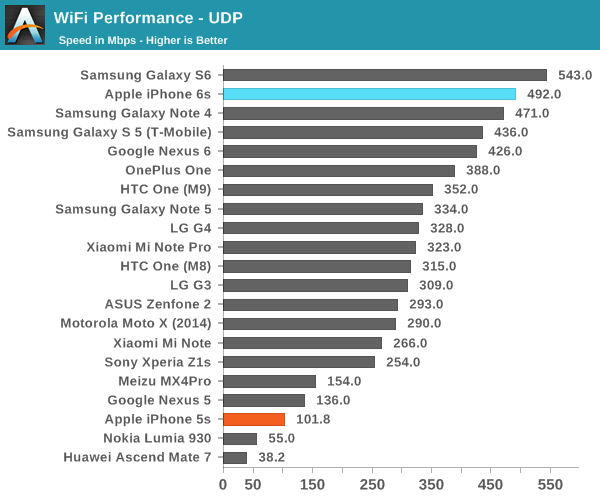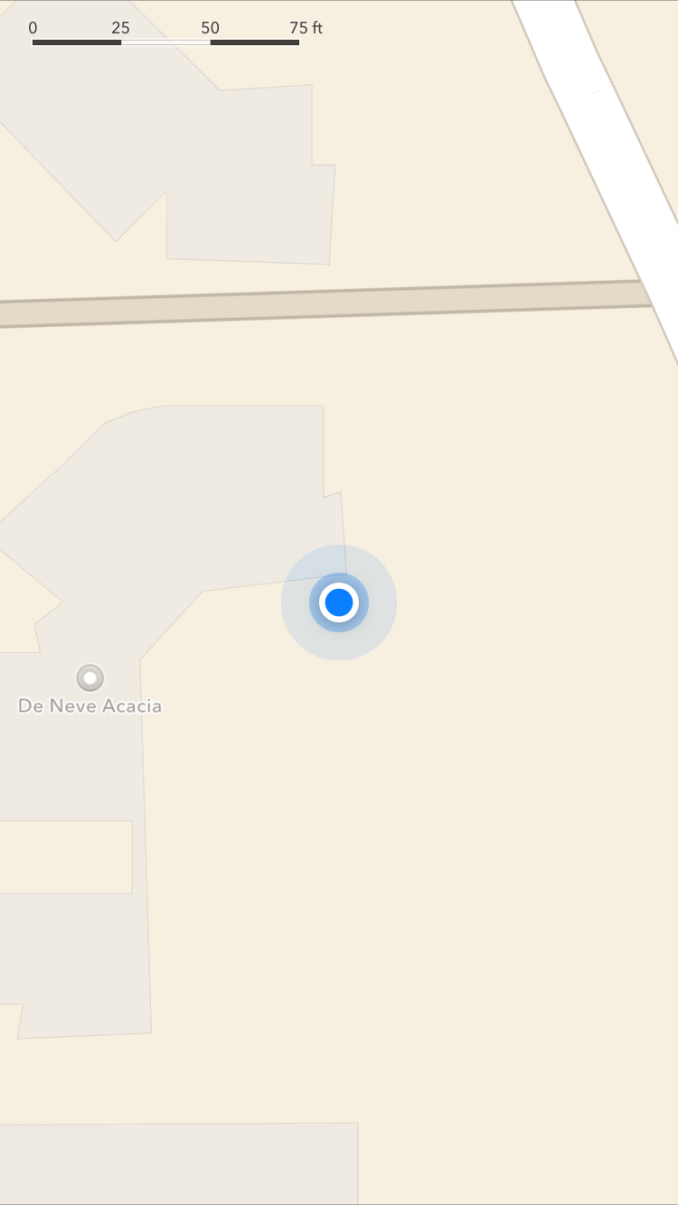The Apple iPhone 6s and iPhone 6s Plus Review
by Ryan Smith & Joshua Ho on November 2, 2015 8:00 AM EST- Posted in
- Smartphones
- Apple
- Mobile
- SoCs
- iPhone 6s
- iPhone 6s Plus
WiFi Performance
While cellular data is often the center of smartphone connectivity, it’s often the case that people rely on WiFi instead of cellular data for the bulk of their data transfers. As a result WiFi is a pretty important part of the overall smartphone experience. In the case of the iPhone 6s, the major change from the iPhone 6 is that rather than single stream 802.11ac, the iPhone 6s now has dual spatial stream 802.11ac. This increases the maximum physical link rate to 867 Mbps. There’s been some confusion over what’s used for the WiFi chipset, and as far as I can tell this is definitely a Broadcom solution, which is identified as BCM4350 in the system judging by the device ID. This chipset is shared with the Macbook, which is probably helpful for driver development. In order to test how well this performs, we use iperf2 in UDP mode to attempt to determine maximum practical bandwidth. It’s worth noting here that the iperf2 ports on iOS are still amazingly buggy though, so these results are no guarantee as far as I can tell.

Interestingly enough, for whatever reason the iPhone 6s holds a minor lead over most of the other devices in this test. I’m not sure what’s causing this, but in practice I found that WiFi on the iPhone 6s worked without any noticeable issues. Reception is noticeably improved when compared to the iPhone 6 due to the addition of a second spatial stream which means that throughput at the same distance is higher.
GNSS
Accurate location is often critical to a number of popular applications for smartphones like any kind of navigation or mapping application, which is going to be an incredibly painful experience if the GNSS system in the phone has poor sensitivity to the signals used in the various GNSS systems available today. Although I have no hard evidence to go on, given the use of a Qualcomm modem in this phone I strongly suspect that this phone is using Qualcomm's IZat location services. I would normally run some cursory testing here with a GPS test application, but because iOS offers no way to clear assistance data and location services are disabled if there is no prior connection to download assistance data, there's no way to do the usual cold lock testing.
A warm lock in which connection was immediately established to begin downloading assistance data achieved lock within 15 seconds, and in general I've never had issues with location services in the iPhone 6s in my time using it.
Misc
Over the course of the review, there are a lot of various bits and pieces that I learn about a phone that might be of interest, but aren’t necessarily examined in intense depth because of either limitations in our testing or the issue of interest isn’t significant enough to examine closely. For example, the fuel gauge appears to be a TI design win as there are references to a BQ27540 chip. The A9 SoC also contains a dedicated AES accelerator for things like full disk encryption and FairPlay DRM. The display backlight appears to use the TI LM3539 driver, but other evidence within the system suggests that this isn’t the only backlight driver for the display.
On the audio side of things, although I haven’t been able to do deep investigations into audio quality it appears in the system that the audio codec used is Cirrus Logic’s CS42L71 which also appears to be responsible for microphone input. However, instead of using an amplified on the audio codec a dedicated amp is used for the speaker, which appears to be a Cirrus Logic CS35L21. Subjectively, the speaker sounds pretty similar to the iPhone 6, but at the high end of the volume range it feels like volume was increased while also increasing distortion. Turning down the volume to a comparable level makes both sound pretty much the same.
More reading of the system files reveals some noticeable codenames like Stockholm which appears to be related to NFC and payments in some way. The fingerprint sensor is referred to as Mesa, and the authentication/secure element appears to be Sand Dollar. The charger chip is referred to either as SN2400 or Tigris. Some sort of accessory detection chip is referred to as TriStar2 or CBTL1610. The ambient light sensor is referred to as CT821 but I can’t find anything on what this is at all.











531 Comments
View All Comments
IanHagen - Wednesday, November 4, 2015 - link
I read on my phone all the time. It's great to have my library in my pocket and being relieved of carrying heavy books wherever I go.Caliko - Tuesday, November 3, 2015 - link
A higher resolution wouldn't make a difference(besides pleasing spec junkies).jospoortvliet - Wednesday, November 4, 2015 - link
Of course it would. Putting my HTC One m7 next to the latest iPhone shows the latter has simply less crisp text. The screen is awesome besides that but don't go and deny it has almost the same resolution as the cheap Moto G I bought for my wife... Just as it has taken Apple a long time to finally deliver a larger screen (though with a bang) and just as they keep sporting ridiculous bezels, the low resolution is both factual and a noticeable compromise. I suspect they just have a too rigid ecosystem of apps which is not build for responsive screen sizes, unlike Android.Of course it doesn't make the 6s any less amazing as a phone, it might not be the best on every aspect but it is very close and seems well deserving of the gold. Too bad it is an Apple product, closed off and locked down. The day I can just plug a normal USB cable in and it will present itself as a normal USB storage device to my OS (Linux), and I can replace all proprietary cloud services with my own, switch app store and use open source apps I might consider it. Until then - thanks but no thanks.
Caliko - Tuesday, November 3, 2015 - link
You're so full of it. The resolution is beyond what your eyes can distinguish.I can't believe in 2015 I STILL have to explain this. Feels like 2006 again....
Alexey291 - Tuesday, November 3, 2015 - link
Nope you're really really wrong. And yes in 2014 people even at apple realised that 330ppi is too little. They are just you know... Behind...lurker22 - Monday, November 2, 2015 - link
Or, it could be that the phone is really the best right now... maybe if android manufacturers would agree to stop abandoning their devices they would get more "bests." Something I noticed about android people, you're constantly whining whenever someone says the iPhone is a fantastic device.I have a Nexus 7, its ok, but wow is it not smooth or easy to maintain...i ended up installing a task manager to just get web browser to be somewhat less jerky on large pages.
SaolDan - Monday, November 2, 2015 - link
Come on dude. I dislike apple a lot but that being said they have very good hardware. Software sucks and a iPads i don't see a use for iPads specially the "pro" version specially when u can get a surface pro 4 for the same price but again their SOC are really really fast. im sayting this as someone who looks down on iPhones and iPad. I can respect mac os but IOS is garbage. BTW my work and only phone is a company issued iphone 6 so im not just saying all this. SP4 FTW.ASEdouardD - Monday, November 2, 2015 - link
I'd argue that since iOS 8, iOS is very close to Android in terms of functionality, and has the added value of a better App Store. To each his own of course, but I feel the gap between the two OS's is much smaller than it was before. Android's app store is better than it was, and you havec more functionality with iOS than before.SaolDan - Monday, November 2, 2015 - link
I lost my faith in android since 4.4. 4.3 was great. My wife got a lumia 1520 and that thing is awesome. Ive seen a few universal apps and they look great in big and small devices. I think that microsoft continuum would be great if it had a x86 SOC inside. I used to own a lumia 635 and i miss it so much.zeeBomb - Monday, November 2, 2015 - link
Soon ill get my hands on one.